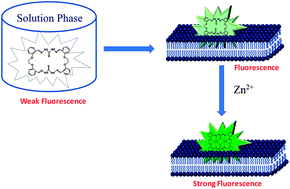Fluorescence-based ion sensing in lipid membranes: a simple method of sensing in aqueous medium with enhanced efficiency
Abstract
Detection of ions in chemical, biological and environmental samples has gathered tremendous momentum considering the beneficial as well as adverse effects of the ions. Generally, most of the ions are beneficial up to an optimum concentration, beyond which they are toxic to human health. However, most of the fluorescence-based ion sensors are only active in non-aqueous solution because of the low solubility of the sensor molecules in aqueous buffer medium. In the present work, we have demonstrated that encapsulation of an aqueous insoluble thiocarbonohydrazone-locked salicylidene-based macrocyclic ligand in 1-palmitoyl-2-oleoyl-sn-glycero-3-phosphocholine (POPC) membranes allows the selective detection of Zn2+ in aqueous medium with approximately 3-fold enhanced efficiency compared to its efficiency in DMSO medium. We have further modulated the charge of the membrane surface by adding various concentrations of a negatively charged lipid, 1-palmitoyl-2-oleoyl-sn-glycero-3-phosphoglycerol (POPG), and showed that negative surface charge further enhances the Zn2+ sensing efficiency up to approximately 6-fold. This strategy opens up a new avenue of utilizing organic sensors to detect vital ions in aqueous medium.



 Please wait while we load your content...
Please wait while we load your content...